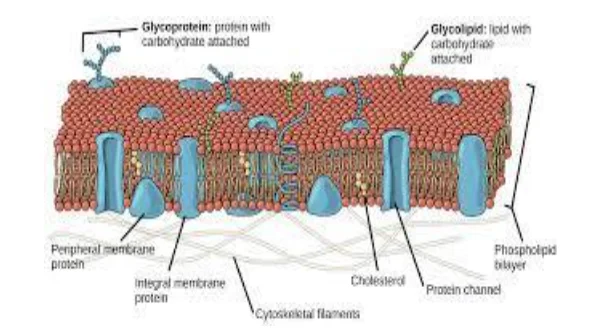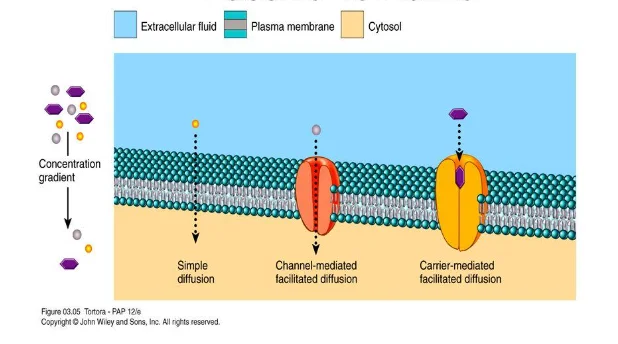Decoding the Fluid Mosaic Model
The Fluid Mosaic Model explains the structure of the plasma membrane of the cell by specifying the different components present in building-up the fluid characteristic of the membrane in supporting passage of different elements to and from the membrane (Wilhelm et al., 2020). The key component which makes up the main fabric of the plasma membrane is phospholipid which is present in bi-layer form to develop the membrane. The cholesterol is attached between the phospholipid bi-layer as well as between the phospholipids. The integral proteins also known as intrinsic proteins have more than one segment that is embedded in the phospholipid layer of the plasma membrane. They contain residue with the hydrophobic side chains which cause interaction with the fatty acyl group leading to protein anchoring to the membrane (Nicolson, 2021).
For those working on similar topics, seeking biology dissertation help can offer valuable insights into these complex interactions. The peripheral proteins are present on the outer or inner side of the membrane and they are not found to be present within the lipid bi-layer (Nicolson, 2021). The transmembrane proteins are present on the outer and inner side of the plasma membrane bi-layer and it form interface of the inner cell to the outside world (Nicolson, 2021). The carbohydrates in the form of glycolipids and glycoproteins are attached to the outer side of the plasma membrane (Nicolson, 2021).

Simple Diffusion
The plasma membrane to support transportation of substance across the membrane used either active transport or passive transport mechanism. The passive transport includes the process of simple diffusion, osmosis and facilitated diffusion to support transfer of substances across the membrane (Sandle, 2018). The simple diffusion occurs when the concentration of the substances is higher on one side of the plasma membrane that is semi-permeable in nature. In this process, the molecule or substance to the passed simply get dissolved in the phospholipid bi-layer to be diffused across the membrane. In this process, only non-polar elements such as carbon dioxide and oxygen are supported to be passed through the membrane down the concentration gradient (Kulbacka et al., 2017).

Osmosis
The osmosis occurs when the water concentration is different on both sides of the plasma membrane. The mechanism involves movement of water from higher solute concentration to the lower solute concentration while building up the osmotic pressure till isotonic state is achieved. The molecules from higher concentration seeps through the fluid membrane to be transported on the other side with lower concentration of the solute (Rivel et al., 2019).
Take a deeper dive into Extraction of Alkaloids from Powdered Plants with our additional resources.
Facilitated Diffusion
The facilitated diffusion process is used for transmission of the substances that are unable to pass the lipid bi-layer due to their increased size and popularity. In this process, the integral membrane proteins are used for moving the polar substances across the regions of the membrane that are hydrophobic in nature. It is executed because the introduction of the polar compounds with the polar central layer present in the plasma membrane structure would otherwise act to prevent or slow the compounds entry inside the cell. Thus, the channel membrane aid the process by forming hydrophilic passage through the membrane bi-layer to support passing of polar and charged elements (Talevi and Bellera, 2018). In this process, the larger compounds are passed with the help of carrier proteins through the channel membrane. This is executed by changing the shape of the molecular compounds on binding with it by the carrier protein which aids it easy entry through the channels (Leven and Levy, 2019).
Looking for further insights on
Active Transport
The active transport is moving the molecules through the membrane with the help of cellular energy that is ATP (adenosine tri-phosphate) from the region of lower concentration to higher concentration. In this process, the sodium-potassium pump is activated by the ATP which causes sodium ions to be pumped out while potassium ions are pumped in creating an electrical gradient against the concentration allowing the substances to pass through the cell. The active transportation of smaller molecules in the cell membrane is carried but by the help of transport proteins which are present inside the membrane (Singh and Bal, 2017).
Endocytosis
The endocytosis is the process in which the plasma membrane engulfs the materials by expanding the phospholipid layer to fold over the substance to be completely engulfed within the membrane (Singh and Bal, 2017).

Exocytosis
Exocytosis is the process of fusion of the secretory vesicles with the cell membrane which results in discharging the content within the vesicle to the extracellular space and include incorporation of new lipids as well as proteins in the membrane. The mechanism includes the substances to be sent to the extracellular space to be are packed within a vesicle in the cell membrane. Thereafter, the vesicle moves to the outer layer of the membrane is gradually released to the outside through the surface of the plasma membrane (Wijesooriya et al., 2018).

References
- Kulbacka, J., Choromańska, A., Rossowska, J., Weżgowiec, J., Saczko, J. and Rols, M.P., 2017. Cell membrane transport mechanisms: Ion channels and electrical properties of cell membranes. Transport across natural and modified biological membranes and its implications in physiology and therapy, pp.39-58.
- Leven, I. and Levy, Y., 2019. Quantifying the two-state facilitated diffusion model of protein–DNA interactions. Nucleic acids research, 47(11), pp.5530-5538.
- Nicolson, G.L., 2021.The Singer-Nicolson Fluid-Mosaic Membrane Model and Membrane Lipid Replacement. Universal Journal of Fluid Mechanics, 9, pp.35-50.
- Sandle, T., 2018. General Data on Cell Membrane and Membrane Traffic. SF J Anal Biochem, 1(2).pp.30-56.
- Singh, S. and Bal, N.C., 2017. Membrane biophysics. In Introduction to Biomolecular Structure and Biophysics (pp. 183-204). Springer, Singapore.
- Talevi, A. and Bellera, C.L., 2018. Drug Absorption. In ADME Processes in Pharmaceutical Sciences (pp. 11-31). Springer, Cham.
- Wijesooriya, C.S., Nyamekye, C.K. and Smith, E.A., 2018. Optical imaging of the nanoscale structure and dynamics of biological membranes. Analytical chemistry, 91(1), pp.425-440.
- Wilhelm, C., Goss, R. and Garab, G., 2020. The fluid-mosaic membrane theory in the context of photosynthetic membranes: Is the thylakoid membrane more like a mixed crystal or like a fluid?. Journal of Plant Physiology, p.153246.
- 24/7 Customer Support
- 100% Customer Satisfaction
- No Privacy Violation
- Quick Services
- Subject Experts



